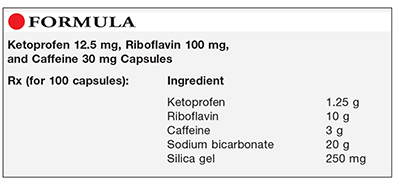US Pharm. 2015;40(1):47-48.

Method of Preparation: Calculate the quantity of each ingredient for the amount to be prepared. Accurately weigh or measure each ingredient. Mix the powders geometrically in a mortar until uniformly mixed. Encapsulate into 100 size #1 capsules. Package and label.
Use: This preparation has been used in the treatment of migraine headache, with two capsules taken at onset and two capsules taken every 4 hours as needed thereafter.
Packaging: Package in tight, light-resistant containers.
Labeling: Keep out of reach of children. Discard after ____ [time period].
Stability: A beyond-use date of up to 6 months may be used for this preparation.1
Quality Control: Quality-control assessment can include weight–overall average weight, weight–individual weight variation, dissolution of capsule shell, disintegration of capsule content, active-drug assay results, physical appearance (color, uniformity, extent of fill, locked), and physical stability (discoloration, changes).2
Discussion: Numerous approaches are available for treating migraine headaches. This compounded formula has been successfully used alone and—in postmenopausal women—in conjunction with bioidentical hormone therapy.
Ketoprofen (C16H14O3, MW 254.28) occurs as a white or almost white, odorless or almost odorless, crystalline powder. It is practically insoluble in water, but freely soluble in alcohol and ether. It has a melting range of 92.0°C to 97.0°C. Ketoprofen has analgesic, anti-inflammatory, and antipyretic properties, and it is an inhibitor of cyclooxygenase.3
Riboflavin (vitamin B2, vitamin G, lactoflavin, C17H20N4O6, MW 376.36) occurs as a yellow to orange-yellow, crystalline powder with a slight odor. Its saturated solution is neutral to litmus. It is very slightly soluble in water, in alcohol, and in isotonic sodium chloride solution. Riboflavin is soluble in dilute solutions of alkalies. It is not appreciably affected by diffused light; however, when in solution, light induces a rapid deterioration, especially in alkaline solutions. Riboflavin plays a physiological role in a number of bodily enzyme systems that are involved in the oxidation of carbohydrates and amino acids.4
Caffeine (C8H10N4O2, MW 194.19) occurs as a white powder or as white, glistening needles, usually matted together. It is odorless and has a bitter taste. Caffeine is sparingly soluble in water and in alcohol. The hydrate is efflorescent in air. Caffeine is a xanthine derivative that occurs naturally in tea and coffee, but for commercial drug use, it is prepared synthetically. The aqueous solubility of caffeine may be increased when it is mixed with sodium benzoate or citric acid. Caffeine has a number of uses as a central nervous system stimulant and in the treatment of apnea of prematurity, headache due to various causes, and (topically) atopic dermatitis.1
Sodium bicarbonate (baking soda, NaHCO3, MW 84.01) occurs as a white, crystalline powder that is stable in dry air, but it slowly decomposes in moist air. Sodium bicarbonate will react with acids, acidic salts, and many alkaloidal salts, and it will evolve carbon dioxide. It can also intensify the darkening of salicylates. Sodium bicarbonate should be preserved in well-closed containers.5
Silica gel, a form of silicon dioxide, is obtained by insolubilizing the dissolved silica in sodium silicate solution. If obtained by adding sodium silicate to a mineral acid, it is called silica gel, but if it is obtained by destabilization of a solution of sodium silicate to yield very fine particles, it is called precipitated silica. Silica gel occurs as a fine, white, hygroscopic, odorless, amorphous powder with a usual particle size of 2 to 10 µm. Silica gel is insoluble in water and alcohol and in other organic solvents, but it is soluble in hot solutions of alkali hydroxides. Silica gel is used as a desiccant, suspending agent, and viscosity-increasing agent.6
REFERENCES
1. U.S. Pharmacopeia 37/National Formulary 32. Rockville, MD: U.S. Pharmacopeial Convention, Inc; 2013:403-453,2058-2059.
2. Allen LV Jr. Standard operating procedure for performing physical quality assessment of powder-filled, hard-gelatin capsules. IJPC. 1999;3:232-233.
3. U.S. Pharmacopeia 37/National Formulary 32. Rockville, MD: U.S. Pharmacopeial Convention, Inc; 2014:3469.
4. Boullata JI. Nutrients and associated substances. In: Hendrickson R, ed. Remington: The Science and Practice of Pharmacy. 21st ed. Baltimore, MD: Lippincott Williams & Wilkins; 2006:1708-1709.
5. Cable CG. Sodium bicarbonate. In Rowe RC, Sheskey PJ, Owen SC, eds. Handbook of Pharmaceutical Excipients. 6th ed. Washington, DC: American Pharmaceutical Association; 2009:629-633.
6. Hapgood KP. Colloidal silicon dioxide. In: Rowe RC, Sheskey PJ, Quinn ME, eds. Handbook of Pharmaceutical Excipients. 6th ed. Washington, DC: American Pharmaceutical Association; 2009:185-188.
To comment on this article, contact rdavidson@uspharmacist.com.





